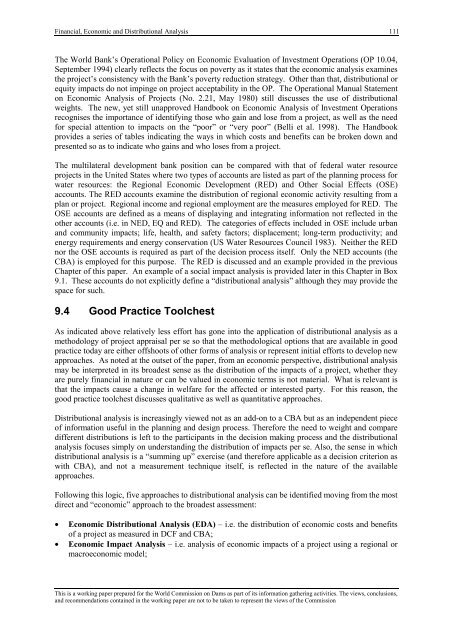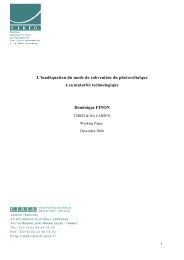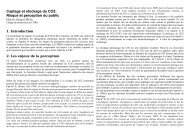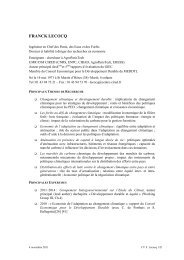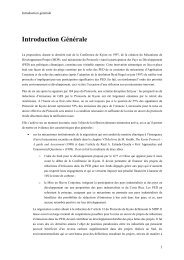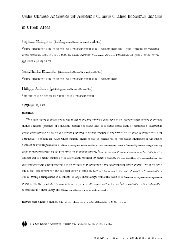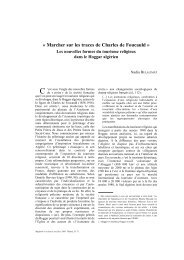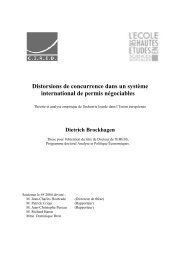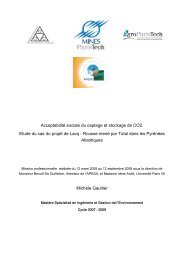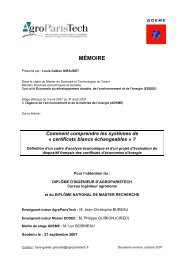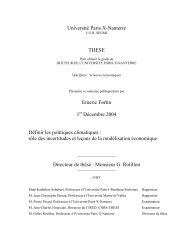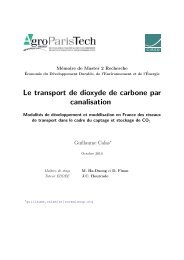Financial, Economic and Distributional Analysis - Centre ...
Financial, Economic and Distributional Analysis - Centre ...
Financial, Economic and Distributional Analysis - Centre ...
Create successful ePaper yourself
Turn your PDF publications into a flip-book with our unique Google optimized e-Paper software.
<strong>Financial</strong>, <strong>Economic</strong> <strong>and</strong> <strong>Distributional</strong> <strong>Analysis</strong> 111The World Bank’s Operational Policy on <strong>Economic</strong> Evaluation of Investment Operations (OP 10.04,September 1994) clearly reflects the focus on poverty as it states that the economic analysis examinesthe project’s consistency with the Bank’s poverty reduction strategy. Other than that, distributional orequity impacts do not impinge on project acceptability in the OP. The Operational Manual Statementon <strong>Economic</strong> <strong>Analysis</strong> of Projects (No. 2.21, May 1980) still discusses the use of distributionalweights. The new, yet still unapproved H<strong>and</strong>book on <strong>Economic</strong> <strong>Analysis</strong> of Investment Operationsrecognises the importance of identifying those who gain <strong>and</strong> lose from a project, as well as the needfor special attention to impacts on the “poor” or “very poor” (Belli et al. 1998). The H<strong>and</strong>bookprovides a series of tables indicating the ways in which costs <strong>and</strong> benefits can be broken down <strong>and</strong>presented so as to indicate who gains <strong>and</strong> who loses from a project.The multilateral development bank position can be compared with that of federal water resourceprojects in the United States where two types of accounts are listed as part of the planning process forwater resources: the Regional <strong>Economic</strong> Development (RED) <strong>and</strong> Other Social Effects (OSE)accounts. The RED accounts examine the distribution of regional economic activity resulting from aplan or project. Regional income <strong>and</strong> regional employment are the measures employed for RED. TheOSE accounts are defined as a means of displaying <strong>and</strong> integrating information not reflected in theother accounts (i.e. in NED, EQ <strong>and</strong> RED). The categories of effects included in OSE include urban<strong>and</strong> community impacts; life, health, <strong>and</strong> safety factors; displacement; long-term productivity; <strong>and</strong>energy requirements <strong>and</strong> energy conservation (US Water Resources Council 1983). Neither the REDnor the OSE accounts is required as part of the decision process itself. Only the NED accounts (theCBA) is employed for this purpose. The RED is discussed <strong>and</strong> an example provided in the previousChapter of this paper. An example of a social impact analysis is provided later in this Chapter in Box9.1. These accounts do not explicitly define a “distributional analysis” although they may provide thespace for such.9.4 Good Practice ToolchestAs indicated above relatively less effort has gone into the application of distributional analysis as amethodology of project appraisal per se so that the methodological options that are available in goodpractice today are either offshoots of other forms of analysis or represent initial efforts to develop newapproaches. As noted at the outset of the paper, from an economic perspective, distributional analysismay be interpreted in its broadest sense as the distribution of the impacts of a project, whether theyare purely financial in nature or can be valued in economic terms is not material. What is relevant isthat the impacts cause a change in welfare for the affected or interested party. For this reason, thegood practice toolchest discusses qualitative as well as quantitative approaches.<strong>Distributional</strong> analysis is increasingly viewed not as an add-on to a CBA but as an independent pieceof information useful in the planning <strong>and</strong> design process. Therefore the need to weight <strong>and</strong> comparedifferent distributions is left to the participants in the decision making process <strong>and</strong> the distributionalanalysis focuses simply on underst<strong>and</strong>ing the distribution of impacts per se. Also, the sense in whichdistributional analysis is a “summing up” exercise (<strong>and</strong> therefore applicable as a decision criterion aswith CBA), <strong>and</strong> not a measurement technique itself, is reflected in the nature of the availableapproaches.Following this logic, five approaches to distributional analysis can be identified moving from the mostdirect <strong>and</strong> “economic” approach to the broadest assessment:• <strong>Economic</strong> <strong>Distributional</strong> <strong>Analysis</strong> (EDA) – i.e. the distribution of economic costs <strong>and</strong> benefitsof a project as measured in DCF <strong>and</strong> CBA;• <strong>Economic</strong> Impact <strong>Analysis</strong> – i.e. analysis of economic impacts of a project using a regional ormacroeconomic model;This is a working paper prepared for the World Commission on Dams as part of its information gathering activities. The views, conclusions,<strong>and</strong> recommendations contained in the working paper are not to be taken to represent the views of the Commission


